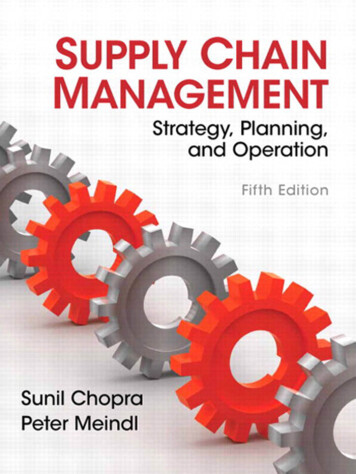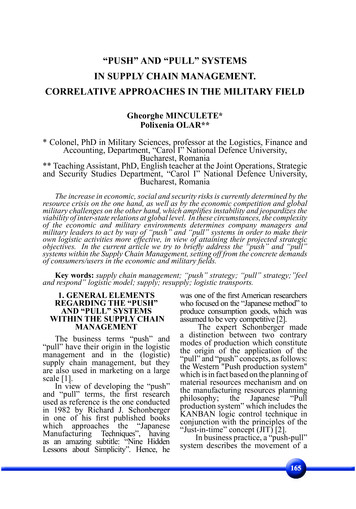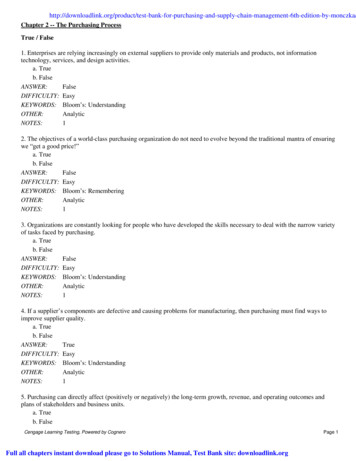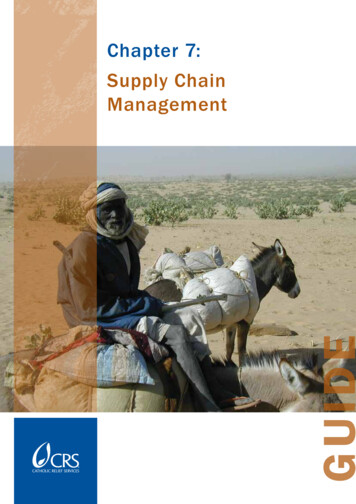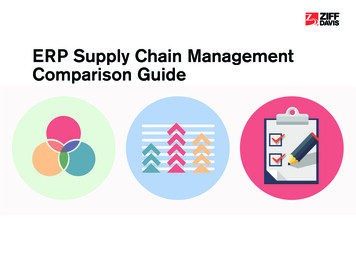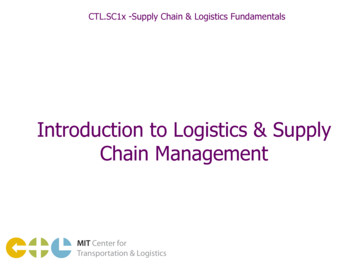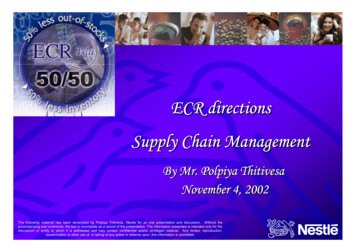
Transcription
ECR directionsSupply Chain ManagementBy Mr. Polpiya ThitivesaNovember 4, 2002The following material has been developed by Polpiya Thitivesa, Nestle for an oral presentation and discussion. Without theaccompanying oral comments, the text is incomplete as a record of the presentation. The information presented is intended only for thediscussion or entity to which it is addressed and may contain confidential and/or privileged material. Any review, reproduction,dissemination or other use of, or taking of any action in reliance upon, this information is prohibited.
Scope of the Supply Chain & LogisticsManagementThis is the a FMCG industry common approach inmanaging Supply Chain and Logistics betweenfactories and customers. Scope of this sessionwill focus on the foundation and for academicpurposes only.Although, it is not suggested that there is only oneway to perform Supply Chain & Logisticsmanagement, the approach outlined here issupported by the ECR.The following material has been developed by Polpiya Thitivesa, Nestle for an oral presentation and discussion. Without the accompanying oral comments, the text is incomplete as a record of the presentation. Theinformation presented is intended only for the discussion or entity to which it is addressed and may contain confidential and/or privileged material. Any review, reproduction, dissemination or other use of, or taking of anyaction in reliance upon, this information is prohibited.
Agenda Supply Chain & Logistics Management Overview Update 5th ECR Conference Singapore Nestle way of managing Supply Chain & Logistics Knowledge Sharing (Q & A )The following material has been developed by Polpiya Thitivesa, Nestle for an oral presentation and discussion. Without the accompanying oral comments, the text is incomplete as a record of the presentation. Theinformation presented is intended only for the discussion or entity to which it is addressed and may contain confidential and/or privileged material. Any review, reproduction, dissemination or other use of, or taking of anyaction in reliance upon, this information is prohibited. c
Supply Chain & LogisticsManagement OverviewThe following material has been developed by Polpiya Thitivesa, Nestle for an oral presentation and discussion. Without the accompanying oral comments, the text is incomplete as a record of the presentation. Theinformation presented is intended only for the discussion or entity to which it is addressed and may contain confidential and/or privileged material. Any review, reproduction, dissemination or other use of, or taking of anyaction in reliance upon, this information is prohibited. c
FMCG Industry ChallengeThe prevailing forces of change with an increasing level of consumersophistication .Stagnant marketHigh CompetitionPrice pressureCost pressure has led to the development of ECRThe following material has been developed by Polpiya Thitivesa, Nestle for an oral presentation and discussion. Without the accompanying oral comments, the text is incomplete as a record of the presentation. Theinformation presented is intended only for the discussion or entity to which it is addressed and may contain confidential and/or privileged material. Any review, reproduction, dissemination or other use of, or taking of anyaction in reliance upon, this information is prohibited.
Efficient Consumer Response (ECR)"WORKINGTOGETHER TOFULFIL CONSUMERWISHES BETTER,FASTER AND ATLESS COST"“GCI”GlobalCommercialInitiativeThe following material has been developed by Polpiya Thitivesa, Nestle for an oral presentation and discussion. Without the accompanying oral comments, the text is incomplete as a record of the presentation. Theinformation presented is intended only for the discussion or entity to which it is addressed and may contain confidential and/or privileged material. Any review, reproduction, dissemination or other use of, or taking of anyaction in reliance upon, this information is prohibited. c
Supply Chain & Logistics ManagementBenefitsThrough the adoption of ECR in Thailand for all channels, it is expected toreduce consumer price by 7.7%, which is equivalent to Baht 38 billion savingacross the erD.C.ConsumerStoreModernChannel*Operatingcosts 2.3%Consumerpricereduction 7.7%Inventorycosts 5.4%TraditionalChannel**Total Supply Chain*Modern Trade: Supermarket chains, hypermarket chains, convenience stores,**Traditional: Mom & Pop Store, independent SupermarketThe following material has been developed by Polpiya Thitivesa, Nestle for an oral presentation and discussion. Without the accompanying oral comments, the text is incomplete as a record of the presentation. Theinformation presented is intended only for the discussion or entity to which it is addressed and may contain confidential and/or privileged material. Any review, reproduction, dissemination or other use of, or taking of anyaction in reliance upon, this information is prohibited. c
Efficient Consumer Response (ECR)Original Objectives & oductsManufacturerReducing inventory &operating costs1.ReducedCostRetailersConsumersmerchandise matching withconsumer demands2.The following material has been developed by Polpiya Thitivesa, Nestle for an oral presentation and discussion. Without the accompanying oral comments, the text is incomplete as a record of the presentation. Theinformation presented is intended only for the discussion or entity to which it is addressed and may contain confidential and/or privileged material. Any review, reproduction, dissemination or other use of, or taking of anyaction in reliance upon, this information is prohibited.EnhancedRevenue
Efficient Consumer Response (ECR)Challenge on Conventional ReplenishmentWhich can in turn drive Continuous Replenishment, which is the process ofusing consumer sales data, combined with joint forecasting for promotions,launches and re-launches, to drive the replenishment of product from themanufacturer to the ribution CentreRetailersDistribution CentreRetail n CentreRetailersDistribution CentreThe following material has been developed by Polpiya Thitivesa, Nestle for an oral presentation and discussion. Without the accompanying oral comments, the text is incomplete as a record of the presentation. Theinformation presented is intended only for the discussion or entity to which it is addressed and may contain confidential and/or privileged material. Any review, reproduction, dissemination or other use of, or taking of anyaction in reliance upon, this information is prohibited.Retail Store
Supply Chain & Logistics ManagementWhat is it?R/M and low of goods. is concerned with the strategy and management of the movement andstorage of materials and products from suppliers, through the Manufacture,firms’ distribution systems to retail outlets and customersThe following material has been developed by Polpiya Thitivesa, Nestle for an oral presentation and discussion. Without the accompanying oral comments, the text is incomplete as a record of the presentation. Theinformation presented is intended only for the discussion or entity to which it is addressed and may contain confidential and/or privileged material. Any review, reproduction, dissemination or other use of, or taking of anyaction in reliance upon, this information is prohibited.
Supply Chain & Logistics ManagementWhat wrong?Demanding Market PlaceA Constrained Supply Chain Capital intensive plant Seasonal raw materials Supplier capacity constraints Limited labour flexibility Large batch sizes Trade capacity constraintsPotential forpoor use ofresources Dominant competition Consumer and tradepromotions Short product life cycles Price changes Customer forward buying& diversionHigh inventory levelsIdle and imprisoned capacityHigh logistics costPoor serviceThe following material has been developed by Polpiya Thitivesa, Nestle for an oral presentation and discussion. Without the accompanying oral comments, the text is incomplete as a record of the presentation. Theinformation presented is intended only for the discussion or entity to which it is addressed and may contain confidential and/or privileged material. Any review, reproduction, dissemination or other use of, or taking of anyaction in reliance upon, this information is prohibited.
Supply Chain & Logistics ManagementWhat are the Challenges in FMCG industry?Minimise Total Cost (while maintaining or improving service) Costs can be minimised by reducing the time that product spends in the supply chainand by increasing the efficiency with which resources are butorCostCostStoreConsumerCostIt is now recognised that optimisation of a single part of the supplychain may lead to a greater total costThe following material has been developed by Polpiya Thitivesa, Nestle for an oral presentation and discussion. Without the accompanying oral comments, the text is incomplete as a record of the presentation. Theinformation presented is intended only for the discussion or entity to which it is addressed and may contain confidential and/or privileged material. Any review, reproduction, dissemination or other use of, or taking of anyaction in reliance upon, this information is prohibited.
Supply Chain & Logistics ManagementShifting of Supply chain cost to the end consumerProduct cost breakdown ateach stage in the chain gPurchased(From alsMaterialsRaw MaterialsSupplyManufacturingDistributorsDealersThe following material has been developed by Polpiya Thitivesa, Nestle for an oral presentation and discussion. Without the accompanying oral comments, the text is incomplete as a record of the presentation. Theinformation presented is intended only for the discussion or entity to which it is addressed and may contain confidential and/or privileged material. Any review, reproduction, dissemination or other use of, or taking of anyaction in reliance upon, this information is prohibited.Total SupplyChainTotalLogisticscosts inthe fullsupplychain
Supply Chain & Logistics ManagementComplexity of FMCG Logistics flow in ThailandTraditional TradeModern istributorRDCWDCWDCRetailersMDC Manufacturer's distribution centreRDC Retailer's distribution centreWDC Wholesale distribution centreTDC Third party distribution centreDistributor Exclusive distributor carrying limited rangeThe following material has been developed by Polpiya Thitivesa, Nestle for an oral presentation and discussion. Without the accompanying oral comments, the text is incomplete as a record of the presentation. Theinformation presented is intended only for the discussion or entity to which it is addressed and may contain confidential and/or privileged material. Any review, reproduction, dissemination or other use of, or taking of anyaction in reliance upon, this information is prohibited.
Supply Chain & Logistics ManagementWhy FMCG needs to have inventory?Inventory is required when a process and its inputs cannot directly satisfythe requirement placed on itInputProcess Mismatch RequirementBig batches/Truck sizesInflexibilityPoor reliabilityInfrequent deliveriesPoor forecastingThe following material has been developed by Polpiya Thitivesa, Nestle for an oral presentation and discussion. Without the accompanying oral comments, the text is incomplete as a record of the presentation. Theinformation presented is intended only for the discussion or entity to which it is addressed and may contain confidential and/or privileged material. Any review, reproduction, dissemination or other use of, or taking of anyaction in reliance upon, this information is prohibited.
Supply Chain & Logistics ManagementTypes of Inventory we are working on.Stock TypeCalculation/DependentsHeld due to productmaturing requirements- Average weekly demand x lengthof incubation period (weeks)Held as a result of timespent in transit- Average weekly demandx Pipeline length(weeks)Safety StockHeld to buffer againstunpredictable demandand supply variability- Cycle length- Demand variability %- Average demand- Planning lead-timeCycle Stock(Production size)Held as a result of thetype of manufacturingregime in placeSeasonal orStrategic StockHeld to cover anticipatedshortages in capacityIncubation Stock(Food products)Pipeline Stock(National campaign)The following material has been developed by Polpiya Thitivesa, Nestle for an oral presentation and discussion. Without the accompanying oral comments, the text is incomplete as a record of the presentation. Theinformation presented is intended only for the discussion or entity to which it is addressed and may contain confidential and/or privileged material. Any review, reproduction, dissemination or other use of, or taking of anyaction in reliance upon, this information is prohibited.1/2 x Cycle Length (in weeks stock)or 1/2 x Batch Quantity
Supply Chain & Logistics ManagementResponse to Consumer Demand - "Push" SystemConsumerInventoryRetail StoresPushPullInformationflowTrade DCsManufacturerModern inventorymanagementtechnique shouldmove away from"pushing" productsinto the holdingareas to .ManufacturerSUPPLY DRIVENSuppliersThe following material has been developed by Polpiya Thitivesa, Nestle for an oral presentation and discussion. Without the accompanying oral comments, the text is incomplete as a record of the presentation. Theinformation pre
Supply Chain Management The following material has been developed by Polpiya Thitivesa, Nestle for an oral presentation and discussion. Without the accompanying oral comments, the text is incomplete as a record of the presentation. The information presented is intended only for the discussion or entity to which it is addressed and may contain confidential and/or privileged material. Any review .


